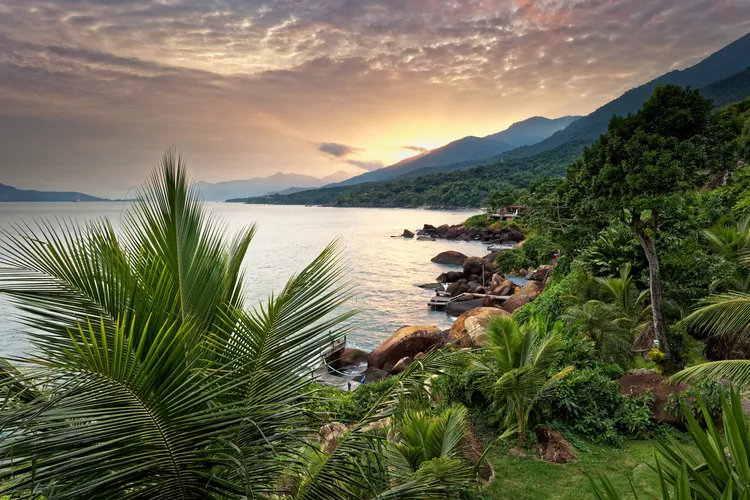Summary
What to See and Do in Brazil’s “Polynesia”
Ilhabela, or Beautiful Island, located on Ilha de São Sebastião in the state of São Paulo, truly lives up to its name. Discovered in 1502 by Amerigo Vespucci, the island has a rich history, including its role in fending off foreign naval powers, serving as a refuge for pirates, a smuggling base, and its involvement in black market slavery.
Approximately 85 percent of the island’s nearly 350,000 square miles is encompassed within Ilhabela State Park, a protected forest area where further development is strictly prohibited. The bulk of the island’s development is located on its west coast facing the mainland, with a flourishing tourism economy.
Ilhabela features 35 kilometers of stunning beaches, lush Atlantic coastal rainforests, a UNESCO Biosphere Reserve, picturesque mountain peaks to summit, and over 400 shimmering waterfalls cascading into the ocean. Moreover, local legends of pirate treasure and intriguing underwater wrecks entice adventure seekers. Ilhabela’s annual Sailing Week is a highlight, showcasing the island’s exceptional sailing conditions, making it a prime vacation destination.
From the summit of Pico São Sebastião, the island’s highest point at 4,521 feet (1,378 meters), visitors can gaze over treetops to the ocean while catching glimpses of local wildlife. At the southern end of the island, the Ilhas das Cabras, part of the Santuário Ecológico de Ilhabela, are dedicated to the protection of marine wildlife. This vantage point also offers panoramic views of other islands in the archipelago, which spans approximately 130 square miles with around 84 miles of coastline.

Getting There
Ilhabela is situated 210 miles south of Rio de Janeiro and 138 miles north of São Paulo. From São Paulo, a drive takes approximately three hours to São Sebastião, followed by a 15-20 minute ferry ride to Barra Velha on the island, with bus connections available to the hamlet of Vila Ilhabela, also known as the Centro. Utilizing a road access map can help navigate this journey.
Ilhabela is particularly popular among sailors, offering various marinas and guest berths. There is also a helicopter pad located on the east coast, where island tours can be arranged.
When to Go
The average annual temperature hovers in the comfortable 70s °F, making Ilhabela a year-round favorite. However, the summer months or weekends tend to be busier with mainland visitors. Traveling during the offseason or weekdays may offer a more peaceful experience, although numerous beaches often provide private spots for sunbathing or enjoying nature.
For diving enthusiasts, the best months are between October and March. Sailors should not miss Ilhabela during Sailing Week in July, when international sailors participate in exciting races and regattas. Furthermore, the ocean between São Sebastião and Rio de Janeiro is recognized for its excellent cruising conditions, bolstered by numerous facilities for sailors.
Lodging, Dining, and Practical Tips
The west coast of Ilhabela is the most heavily populated, boasting a range of hotels, restaurants, and lively crowds. Alternatively, the east coast offers a more secluded experience with wild, scenic white sandy beaches. Due to the high cost of lodging on the island, many visitors prefer to stay in São Sebastião and commute via complimentary ferries, allowing for day trips to Ilhabela.
Seafood is abundantly available, and the local Ilhabela prawns are renowned for their exceptional sweetness and flavor.

Activities
Ilhabela is a haven for outdoor recreation, particularly for water sports. Sunbathing on its picturesque beaches provides a wonderfully relaxing way to spend the day. Don’t forget to apply sunscreen and insect repellent; although numbers are decreasing due to control measures, tiny Borrachudo bugs—somewhat like mosquitoes—can still be bothersome, especially at twilight.

Things to Do on Land
When it comes to beach access, the most popular spots on the west coast near Vila include Praia do Curral, Praia Grande, and Praia Feiticeira, where beachside restaurants offer delicious food and drinks, especially the caipirinhas made with sugarcane rum.
Feiticeira, or Sorcerer’s Beach, is rumored to conceal hidden pirate treasure. The most stunning and untouched beaches lie on the island’s east side; however, they are more challenging to reach. Some require traversing rough roads or trails, and a few are accessible only by boat.
Engage in a variety of exciting activities:
- Praia dos Castelhanos: This completely undeveloped bay was once a hideout for pirates, with legends of British pirate Thomas Cavendish burying fabulous treasures here.
- Visit Igreja da Matriz: Explore this beautiful colonial church built in 1908 located in-town.
- Fazenda Engenho D’água: While not open to visitors, glimpse the colonial plantation’s historic beauty on your journey from the ferry.
- Horseback Riding: Rent a horse to traverse the mountain trails or gallop along Castelhano beach.
- Mountain Biking: Tackle the steep, thrilling hilly trails and pause at spectacular waterfalls like Cachoeira do Gato.
- Rappelling: Experience thrilling descents along cliffs and waterfalls.
- Hiking: Trekking in the state park allows exploration of diverse Atlantic rainforest flora and fauna.
- Boat Tours: Take a scenic boat tour around the island with stops at inviting beaches.
- Sailing: Enjoy sailing or take lessons from local sailing schools and yacht clubs in the calm São Sebastião channel.
- Diving and Swimming: Southern Ilhabela is known as Brazil’s Bermuda Triangle, rich with shipwrecks, enticing divers and swimmers alike.
- Surfing: Try surfing at Castelhanos and Bonete, with plenty of options for divers at nearby beaches.
- Ihals das Cabras: This area attracts divers eager to discover its underwater ecological sanctuary.
- Windsurfing: Optimal spots include Ponta das Canas, Ponta Azeda, and more depending on the wind conditions.
- Deep-Sea Fishing: Engage in deep-sea fishing for marlin, tuna, or albacore, utilizing catch-and-release techniques.

Things to Do on the Mainland
Make sure to visit São Sebastião’s colonial buildings, many of which are recognized for their historical significance. Numerous beaches await exploration both south and north of the town, with Enseada, Cigars, Guaecá, Toque-Toque Grande, Toque-Toque Pequeno, Paúba, Maresias, Boissucanga, Camburi, Barra do Sahy, and Juquehy being the most popular.





